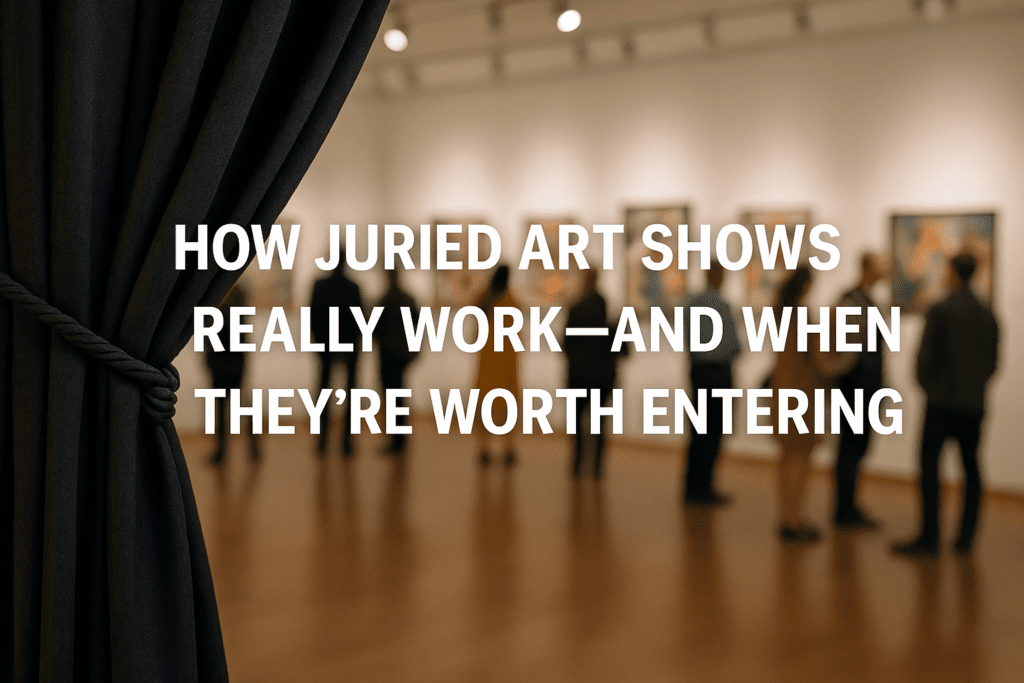

Having served as a juror for multiple exhibitions, I can say with confidence: most of the time, it’s not as mysterious as you might think.
In many cases, the process is handled by a single juror—often an artist, curator, or art professional—who is given access to a database of submissions. That juror is expected to narrow the field down to a predetermined number of accepted pieces.
Here’s how I (and many jurors I know) tend to approach the process:
-
Initial Pass: Scroll through every single submission without judgment. This gives a general sense of the scope and tone of the entries.
-
Quick Sort: Go back through and make a quick thumbs-up/thumbs-down decision—this is largely instinctual and based on initial impact.
-
Deep Review: Finally, go through the top picks slowly, considering not just the image quality but also the accompanying artist statement, technical execution, and how the work fits the theme (if applicable).
In group jury situations, each juror typically scores submissions independently. The final list is often determined by consensus—identifying overlap, negotiating differences, and occasionally trading picks. But whether it’s a solo or multi-juror setup, it’s rare for gallery owners to override or micromanage the results.
In short, it’s not a political process—it’s a visual one.
Is the Gallery Owner Involved?
If the show is hosted by a nonprofit art organization, the answer is almost always no. In gallery-hosted events, the owner might serve as one of the jurors, but they’re typically not going to second-guess the invited juror’s decisions. I’ve juried shows hosted by both types of organizations and the rule has been consistent: once I make my selections, the list is accepted as final.
If a gallery is using juried exhibitions as a way to scout new artists (and some do), then your submission might result in a second look down the road. But that’s not guaranteed, nor should it be your primary expectation.
So, Are Juried Shows Worth It?
It depends on what you’re hoping to achieve.
Here are the real benefits:
-
Exposure to new audiences. A well-promoted show gives your work visibility in a new market or city.
-
Networking. You’re often shown alongside artists you might not otherwise meet. That can lead to connections, collaborations, or referrals.
-
Credibility. For artists still building their résumé, juried shows can help establish a track record of public exhibition.
-
Feedback. If you notice certain pieces consistently get accepted (or consistently don’t), that’s data worth paying attention to.
But juried shows come with trade-offs. Entry fees, framing and shipping costs, and the time required to prepare submissions all add up. If your primary goal is sales, there may be more direct ways to achieve that—especially if the show’s audience isn’t collector-heavy.
How to Prepare a Strong Submission
The key is to make the juror’s job easy.
-
Choose your strongest pieces. This isn’t the time to test experimental new work unless it’s truly exceptional.
-
Submit professional images. Poor photography or distracting backgrounds are automatic disqualifiers.
-
Tailor to the theme. If the show is themed, don’t try to shoehorn your work into it unless it genuinely fits.
-
Don’t overthink your statement. A clear, concise explanation that supports the work is better than flowery language.
The juror is likely reviewing dozens—if not hundreds—of entries in a short window. The more compelling your work is at a glance, the better your chances.
What Are the Alternatives?
If juried shows aren’t a fit for your goals or budget, there are other ways to gain similar benefits:
-
Participate in online showcases or virtual gallery exhibitions. These often have lower costs and a wider reach.
-
Look for open-call catalogs (like the ones we publish). A printed catalog shared with collectors can generate interest in your work—and sales.
-
Collaborate on pop-up exhibits or open studios. These allow you to control the environment and keep all proceeds from sales.
-
Focus on building your own mailing list and inviting collectors to private viewings. This creates a direct connection without the gatekeeping.
Final Thoughts
Juried shows can be a valuable part of your overall strategy, especially early in your career or when trying to break into a new market. But like anything else in your art business, they should be approached with clear goals and realistic expectations.
If you find yourself submitting to every juried opportunity just because it’s there, take a step back and evaluate whether it aligns with where you want to go. Your time and resources are limited—spend them where they’ll move you forward.
Let me know in the comments: Have juried shows helped you grow your art business? Are there strategies or red flags you’ve learned to watch for?






